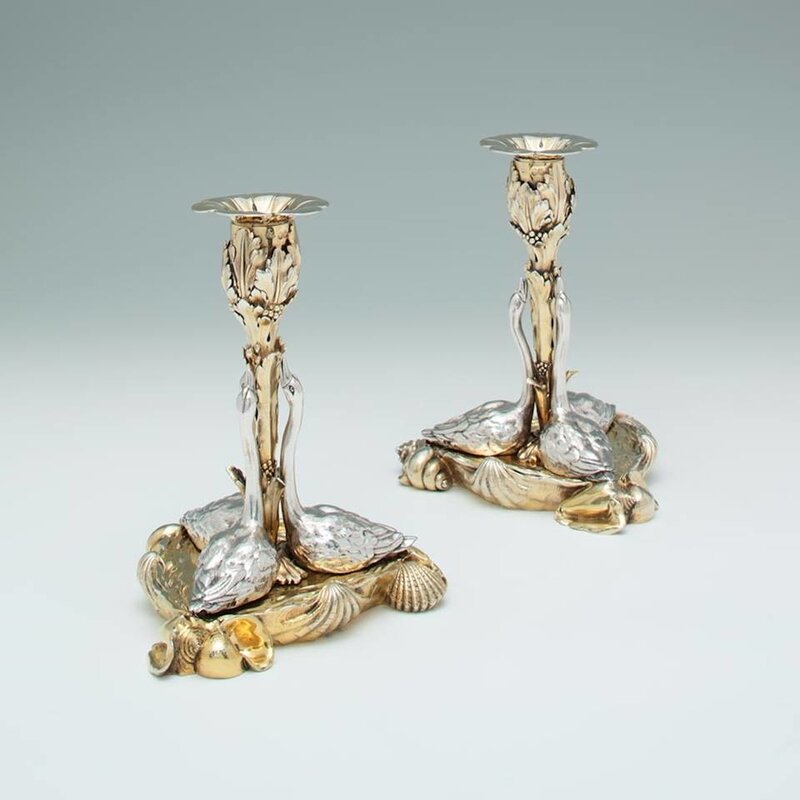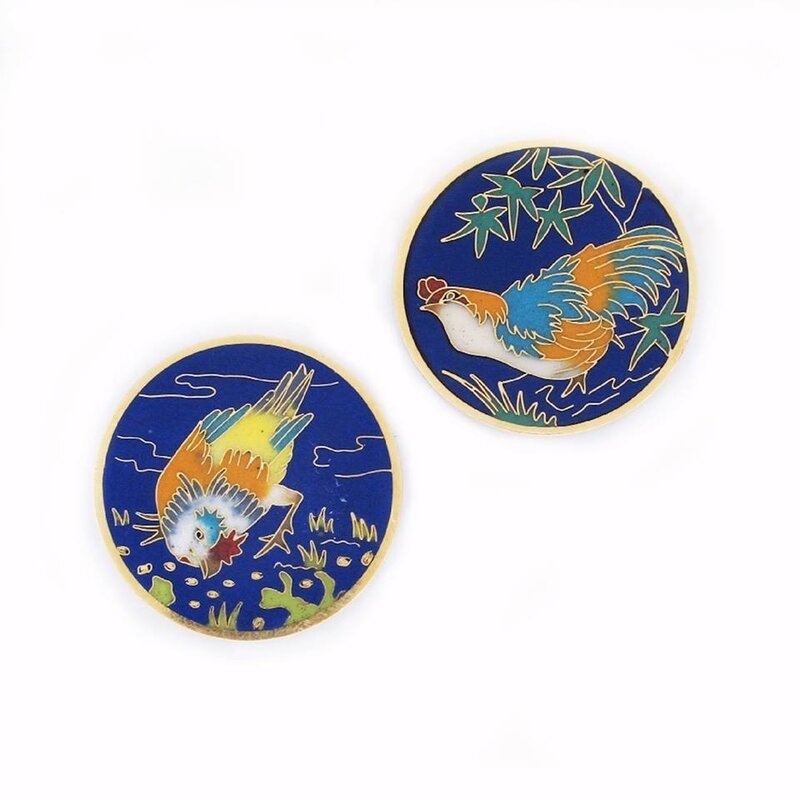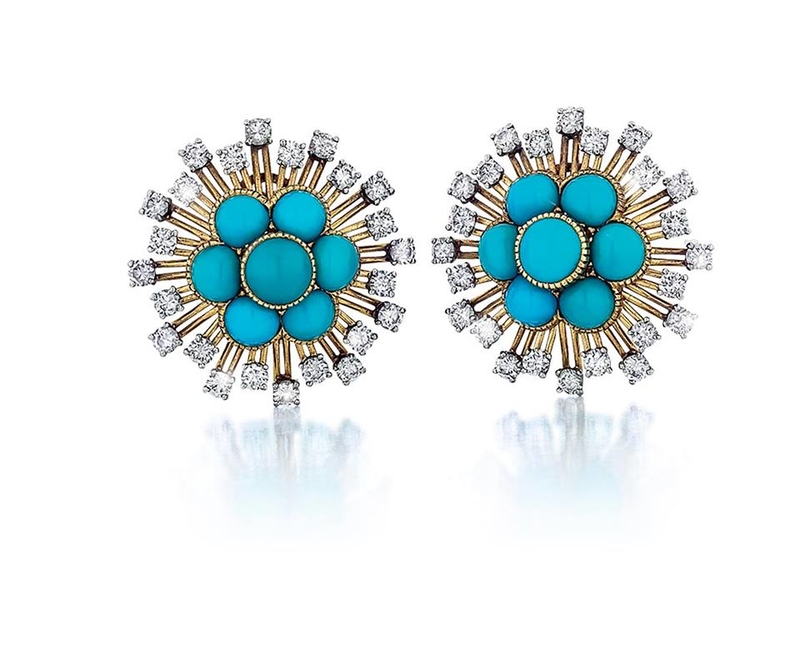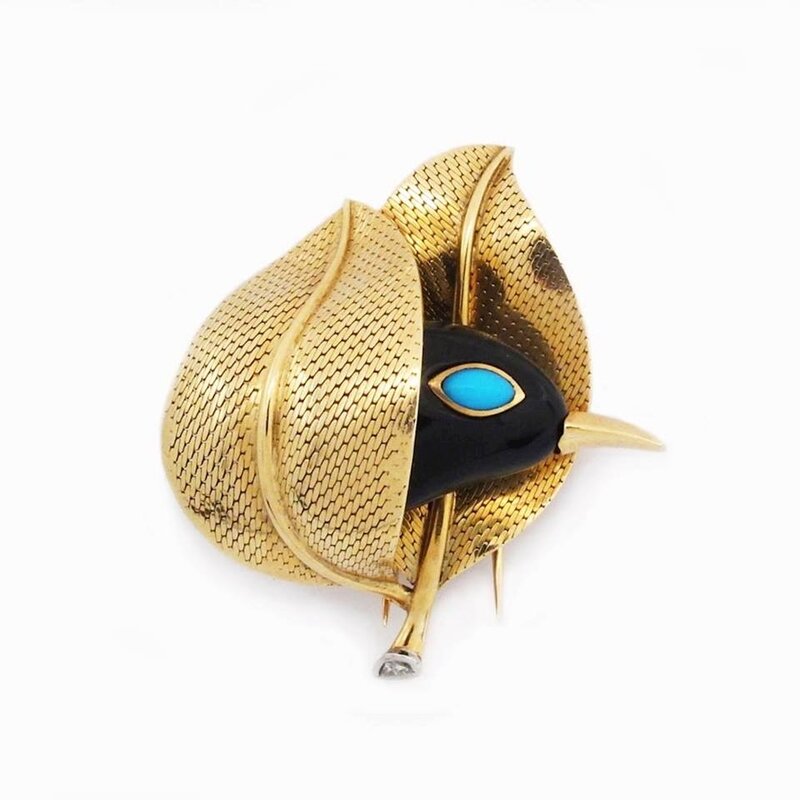S. J. Shrubsole, Corp., Stand 334 at TEFAF New York Fall 2018
Francis Leake, A Charles II antique tankard, London, 1673. Silver-Gilt. Height 17.1 cm (6.7 in.). Fully Hallmarked. Image courtesy S. J. Shrubsole, Corp. / Stand 334.
This tankard was given as a Bequest by the Archbishop of Canterbury.
Engraved with the Latin inscription “Legatum Amicissimi Reverandissimi in Christo Patris Thomae Nuper Cantuar Archiepi”. The inscription relates to a bequest in the will of Thomas Tenison, Archbishop of Canterbury, dated 1715: “I give and bequeath unto the Rt. Rev. Father in God, Charles, Lord Bishop of Norwich, one of my gilt Tankards as also my gilt Caudle Cup and my silver shaving basin and ewer…".
Thomas Tenison (1636-1715) was the Archbishop of Canterbury from 1694 to 1715. During the Great Plague in London he gained much credit for his care of the parish and was presented with a handsome piece of plate by the parishioners in thanks. In 1687 he preached the funeral sermon of Nell Gwynne, a royal mistress, in which he said much to her praise and represented her as a penitent soul. He became Archdeacon of London in 1689, Bishop of Lincoln in 1692 and finally Archbishop of Canterbury in 1695. His charitable endeavors included the erection, in 1695, of the first public library in London.
Dr. Charles Trimnell (1663-1723), was the Bishop of Norwich (1708-1721) and later Bishop of Winchester (1721-1723). His second wife was the daughter of Sir Edmund Winn, 2nd Bt. of Nostel, co. York. He died without surviving issue, the tankard then passing to his wife’s family, where it has remained ever since.
Provenance: Thomas Tenison, Archbishop of Canterbury, and bequeathed to Dr. Charles Trimnell; Bishop of Norwich; his wife Elizabeth; thence by descent in the Winn family; Christie's, London, 4 March 1992, lot 199.
Isaac Dighton, A Royal Charles II antique porringer and stand, London, 1679. Silver-Gilt. Diameter 28.9 cm (11.4 in.). Hallmarked. Image courtesy S. J. Shrubsole, Corp. / Stand 334.
James Scott was the eldest and favored son of King Charles II. In 1662 he married the Countess of Buccleuch, was created 1st Duke of Monmouth, and was nominated a knight of the Garter. The marriage, which took place on 20 April 1663, was the event of the season, taking place in the King’s Chamber at Whitehall; that same day James was created Duke of Buccleuch, Earl of Dalkeith and Lord Scott of Whitchester and Eskdale. Monmouth served in the Second Anglo-Dutch War and commanded troops in both the Third Anglo-Dutch War and the Franco-Dutch War.
When Charles II died in 1685 he was followed not by his son Monmouth, who was illegitimate, but by his brother James II. James was a Catholic and extremely unpopular, so Monmouth, a flamboyant favorite, the dead King's eldest son, and a good Protestant, led the unsuccessful Monmouth Rebellion in an effort to depose him. Monmouth gained support in the West Country but was defeated at the Battle of Sedgemoor and beheaded.
Provenance: James Scott, Duke of Monmouth (1649-1685); General John Ramsay (1768-1845), sold at Christie & Manson, London, 19 June 1855; purchased by Sir William Stirling-Maxwell, 9th Baronet of Keir (1818-1878); Brigadier General Archibald Stirling, of Kier (1867-1931); William Joseph Stirling (1911-1983); Archibald Hugh Sterling, of Keir (b. 1941).
Exhibited: London, Royal Academy, 'Exhibition of British Art', January 1934, no. 1375, p. 457, lent by Mr William Joseph Stirling.
John Bridge, A pair of George IV antique candlesticks, London, 1825. Silver and Parcel-Gilt. Height 17.1 cm (6.8 in.). Fully hallmarked and inscribed with Latin inscription for Rundell, Bridge, and Rundell. Image courtesy S. J. Shrubsole, Corp. / Stand 334.
The crest and coronet are those of Plymouth, for Other Archer Windsor, 6th Earl of Plymouth (1785-1833). In 1811, he married Mary (1792-1864), 1st daughter of John Frederick Sackville, 3rd Duke of Dorset at her family's estate Knole, Kent. The Earl and Countess lived at Knole for several years following the death of her mother in 1825, and these candlesticks were probably commissioned then.
Provenance: Trustees of the Knole Estates; sale Christie's, London, May 20, 1987, lot 134; sale Christie’s New York, April 19, 2002, lot 344, $59,750.
Literature: various, The Glory of the Goldsmiths: Magnificent Gold and Silver From the Al-Tajir Collection”, London, 1989, 158, p. 205.
Exhibited: London, Christie's, 'Treasures from National Trust Houses', 1958, no. 193; London, Christie's, 'The Glory of the Goldsmith: Magnificent Gold and Silver from the Al-Tajir Collection', 1989, no. 158.
Tiffany and Co. An antique American cup and saucer, New York, 1880. Silver and other metals. Diameter 17.7 cm (7 in.). Fully marked, stamped 'TIFFANY & CO./5520M922/STERLING-SILVER/AND OTHER METALS 824', engraved 'M.T. de P 1880' and with French import marks. Image courtesy S. J. Shrubsole, Corp. / Stand 334.
Silver with hand-hammered surface, applied with Japanese style designs in copper and gold.
Tiffany was known for superb Japanese style designs in the late 19th century. The large, exuberant butterflies on this piece are most unusual.
A pair of Colombian emeralds and diamonds pendant earrings, circa 1850. Length 3.8 cm (1.5 in.). Image courtesy S. J. Shrubsole, Corp. / Stand 334.
Silver over 18K yellow gold, each drop formed by a cushion shaped emerald in diamond border pendant from smaller cluster tops with two diamonds in between. The larger Colombian emeralds are approximately 1.85 ct and 1.81 ct, and the smaller ones are approximately 0.4 ct each, the 52 diamonds are approximately 4.7 cts.
Accompanied by a GIA report stating that the emeralds are natural unheated Colombian emeralds.
Castellani. A Victorian antique brooch, London,circa 1870. Enamel and Gem-Set. Width 5.1 cm (2 in.). Marked. Image courtesy S. J. Shrubsole, Corp. / Stand 334.
18K yellow gold, of quatrefoil form centered with a raised cross set with small cabochon rubies and emeralds, the surround enameled in blue and turquoise within rope work edging, with four projecting pearl finials, marked on back.
Alexis Falaise, A pair of cuff buttons, Paris, circa 1880. Enamel and Gold. Diameter 2.5 cm (1 in.). Marked. Image courtesy S. J. Shrubsole, Corp. / Stand 334.
18K gold, each circular with a champlevé image of a rooster, central circular backing stamped with a maker and eagle head mark.
Alexis Falize is well-known for superb enamel-work, and was profoundly influenced by Japanese design and technique.
Cartier, A pair of French turquoise and diamond cluster earrings, Paris, circa 1955. Diameter 2.5 cm (1 in.). Signed and marked. Image courtesy S. J. Shrubsole, Corp. / Stand 334.
Detailed material description: 18K yellow gold, each formed as a cluster of cabochon turquoises within a starburst of diamonds set in platinum prongs (48 brilliant cut diamonds approximately 2.6ct total weight), clip backing, signed Cartier Paris and stamped with French gold, platinum and maker’s marks.
Cartier, Turquoise onyx and gold brooch, Paris, circa 1960. Height 5.1 cm (2 in.). Signed and marked. Image courtesy S. J. Shrubsole, Corp. / Stand 334.
18K yellow gold, formed as a black onyx bird’s head with turquoise eye peaking out of textured gold leaves, the stem terminating with a triangular cut diamond, signed Cartier Paris 012108 and stamped with French gold and maker’s mark.
S. J. Shrubsole, Corp. 26 East 81st Street New York, NY 10028 United States of America (212) 753-8920 See map Visit website

/https%3A%2F%2Fprofilepics.canalblog.com%2Fprofilepics%2F1%2F0%2F100183.jpg)
/https%3A%2F%2Fstorage.canalblog.com%2F03%2F02%2F119589%2F96711876_o.jpg)
/https%3A%2F%2Fstorage.canalblog.com%2F11%2F31%2F119589%2F94773502_o.jpg)
/https%3A%2F%2Fstorage.canalblog.com%2F20%2F83%2F119589%2F94772815_o.jpg)
/https%3A%2F%2Fstorage.canalblog.com%2F26%2F72%2F119589%2F75604929_o.jpg)
/https%3A%2F%2Fstorage.canalblog.com%2F59%2F60%2F119589%2F26458628_o.jpg)













/image%2F1371349%2F20240315%2Fob_456a00_f12fdad5-0750-48f5-ae8f-7bd6836745f7.jpg)
/http%3A%2F%2Fstorage.canalblog.com%2F86%2F67%2F119589%2F129815803_o.png)
/http%3A%2F%2Fstorage.canalblog.com%2F40%2F54%2F119589%2F128112000_o.jpg)
/http%3A%2F%2Fstorage.canalblog.com%2F97%2F36%2F119589%2F128062654_o.png)